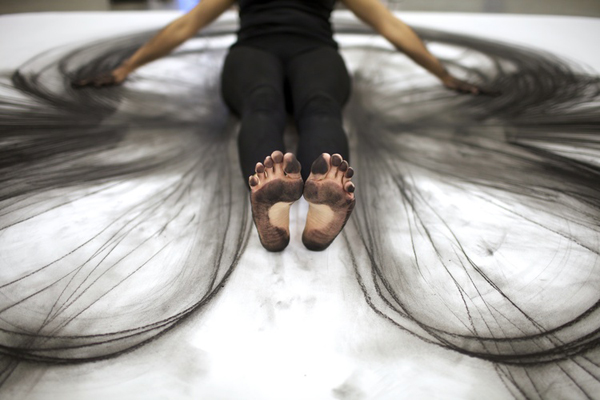“Whenever I leave a work, I feel as if I leave a part of my body behind. There’s a connection – an invisible line…”
– Monika Grzymala (Creative Review, 2011).
//artist blog//
The Age of Love
19th October 2018 – 31st March 2019
BALTIC Centre for Contemporary Art
Heather Phillipson works across video, sculpture, music, drawing, poetry and web projects.
The Age of Love is an installation created to map out an alternate world through video, sculpture and sound.

The installation skillfully combines farm machinery, agricultural and botanical produce, conveyor belts, an enormous polystyrene foot ( made to resemble classical sculptures) as well as screens that showed video material including gulls whose loud squawking can be heard throughout the room.

The lights in the room are set to a purple/ blue which accompanied the psychedelic videos and imagery on the screens as well as the loud pulse noises which can be heard outside of the gallery creating a party like atmosphere.

It’s the purple lights and psychedelic imagery mixed with the sounds that create an alien-like world that I personally enjoyed the most. However, upon entering the gallery space you’re invited to download an augmented reality app created by the artist for this particular exhibition which you then use to see imagery on your phone when pointed at the tv screens with the birds; I liked this as it created an interactive aspect to the work.
A Retrospective
19th October 2018 – 27th January 2019
BALTIC Centre for Contemporary Art
A Retrospective is an exhibition made up of works spanning more than 60 years.

Whilst the exhibition showcases various different works made from different mediums, subject matter, and style; I was immediately drawn to the abstracted geometric sculptures that are spread throughout the main exhibition space.

These geometric forms can be seen sitting on the floor or mounted onto walls and are created using wood then painted ( either fully or partially) using acrylic paints in vibrant colours. Araeen created these sculptures using square and triangle forms and solely worked from memory or his imagination as opposed to working from life.

Carlie Trosclair is an artist who creates site-specific installations that respond to the structure and design of the room. She creates work that not only responds to the space but creates a connection between people and their lives and homes.

Whilst I find all of her work interesting and somewhat inspires me to incorporate more of the everyday life, I found that I was drawn more to her fabric work(s) as fabric is a material I enjoy working with.
Trosclair said that the use of fabrics in a room is to break up the hard edges of the interior by using a material that can relate to the body, giving the viewer a better awareness of the space and their body as they moved through it.
 Detritus, fabric, wallpaper, acrylic paint, chandelier, 10 x 7 x 8 feet, 2008
Detritus, fabric, wallpaper, acrylic paint, chandelier, 10 x 7 x 8 feet, 2008She uses fabric(s) as a way of telling a story through large-scale installation works.‘Traverse’ was an exhibition from 2014 where she stretched a natural tan or blush toned fabric across the clean white walls of the gallery, creating the illusions of cracks in the buildings architecture revealing the plaster or stone underneath.
 ‘Traverse’, fabric, unknown dimensions, 2014, Hartnett Gallery in Rochester, New York
‘Traverse’, fabric, unknown dimensions, 2014, Hartnett Gallery in Rochester, New York
https://www.artfilemagazine.com/Carlie-Trosclair
https://denadadesign.com/carlie_trosclair/
https://carlietrosclair.com/section/413980_Fabric_works_2007_2013.html
Heather Hansen is an artist who creates large scale drawings in charcoal or pastels using only her body as her drawing tool, as a way of combining her love for fine art and dance. She was inspired to create work this way and a series of work called ‘Emptied Gestures’ after visiting the beach a few years back where she had left marks and footprints in the sand after performing a few ballet movements. This isn’t the first time she had made a connection between dance and fine art as she soon realised she visualised the shapes her body creates whilst dancing, motivating her to actually create drawings of the movements.

They shapes and movements she makes whilst drawing are neither completely spontaneous nor fully planned, she visualises an initial shape then improvises and lets her body creates the rest through her meditative state that she goes into whilst performing/create the work.

http://www.ochigallery.com/blog/interview-with-heather-hansen/
Christo (1935-) and Jeanne-Claude (1935-2009) were a married couple who created environmental artworks, using vast amounts of fabrics to compromise the use of an environment.
Whilst many artists have a particular reason or goal to create what they do Christo and Jeanne-Claude say they create for no particular reason or purpose other than their need to create something of joy and beauty. Their works are only available to view for a limited period of time before they are gone forever, they do this as a way of preserving the feelings of love and tenderness within their work.
Before any of the physical environmental works are created there is a period of time where the ideas only exist in their mind and then only in a growing pile of drawings as they put their plans and ideas into motion.

‘Wrapped Reichstag’ (1971-1995) is one of their most recognised works, in which 90 professional climbers and 120 installation workers wrapped the Reichstag in Berlin using 1,076,390 square feet of thick woven polypropylene fabric with an aluminium surface as well as 9.7 miles of blue polypropylene rope. This environmental work took 24 years of planning before completion and was only up for two weeks.

https://christojeanneclaude.net/projects/wrapped-reichstag?view=info
https://www.egonzehnder.com/insight/interview-with-artists-christo-and-jeanne-claude